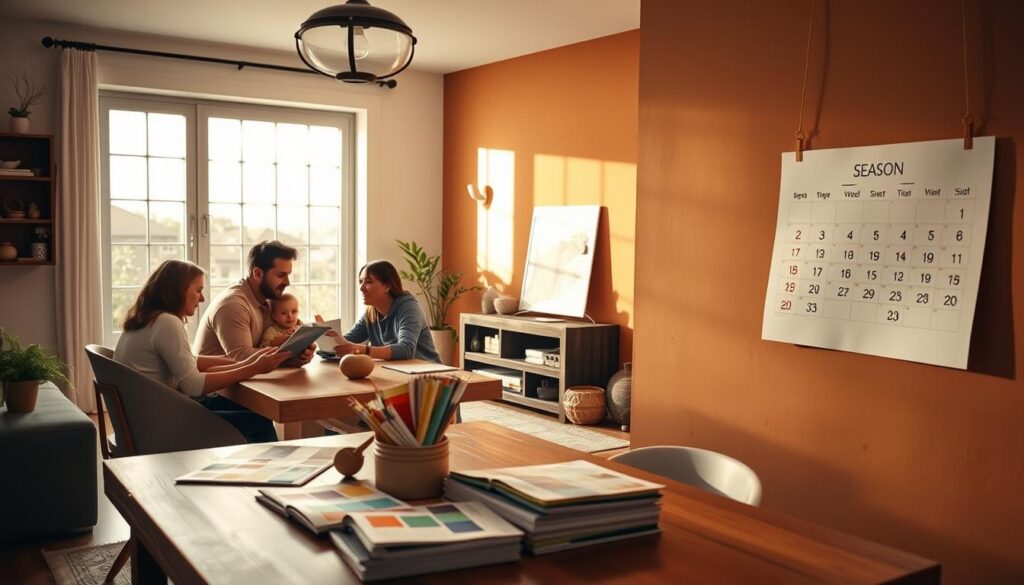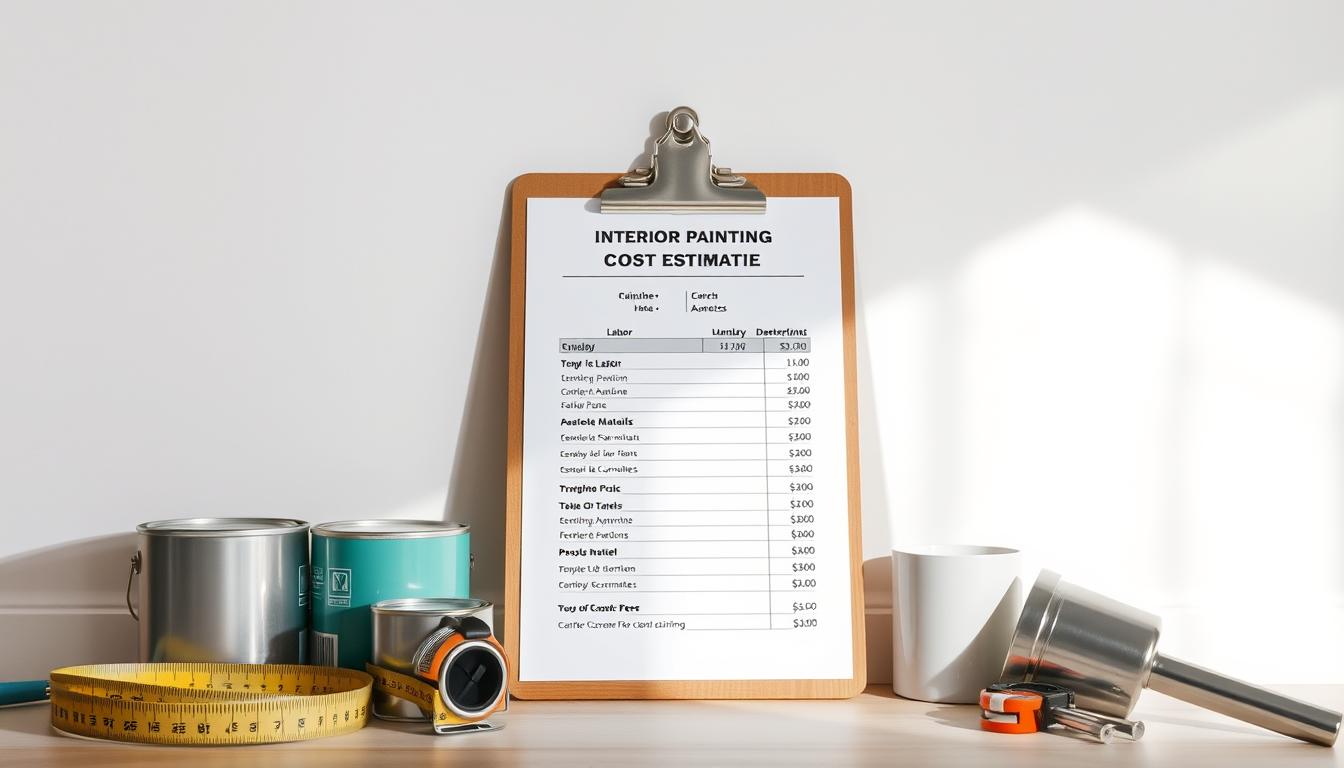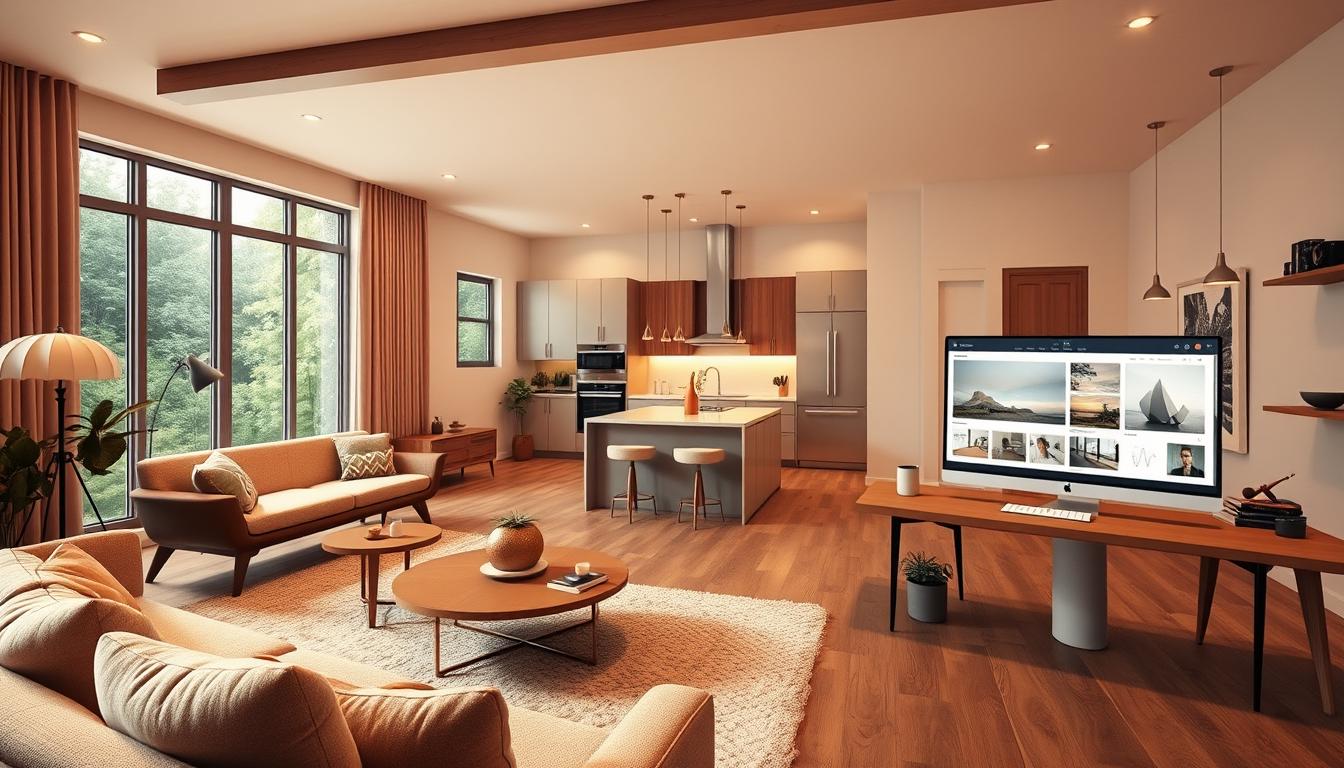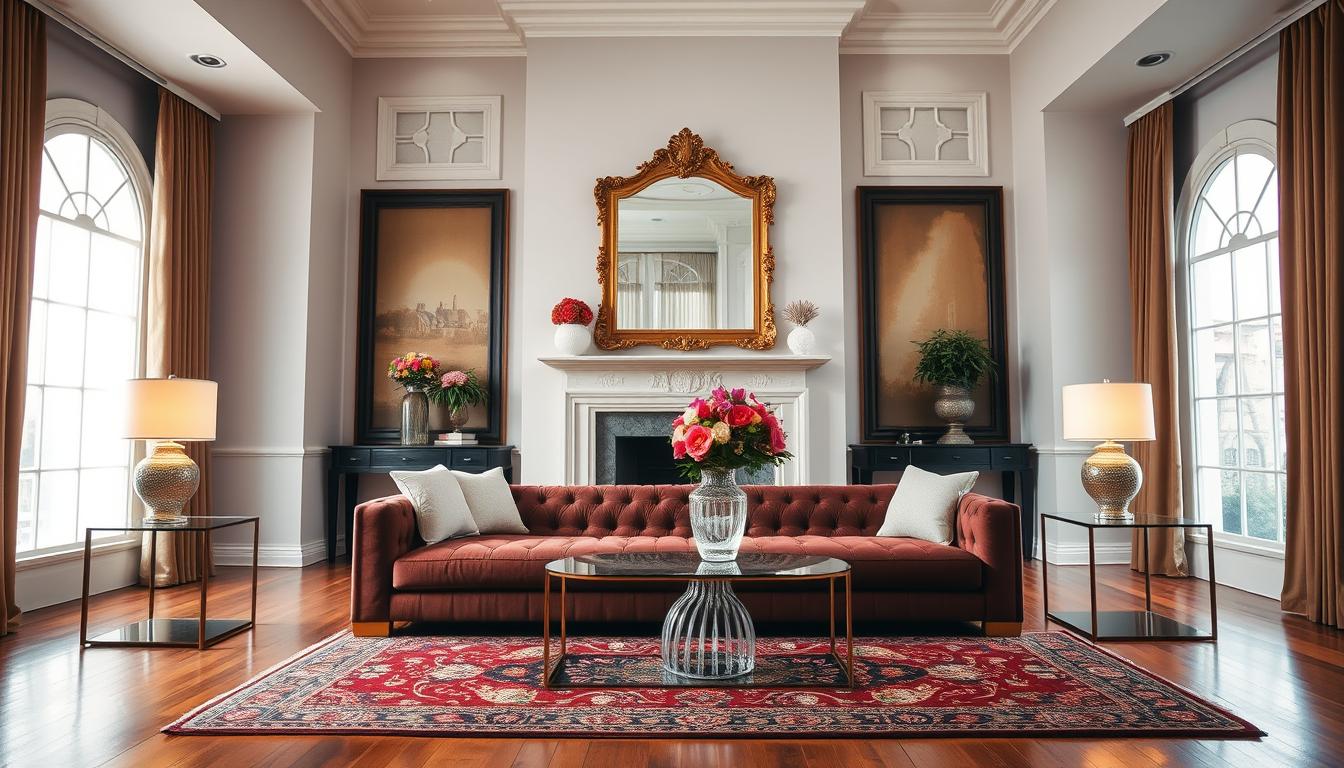Did you know painting your home’s interior can increase its value and look? For a typical 2,000-square-foot home, painting costs can be between $4,000 and $10,000. This depends on the size of your home and the paint you choose.
We’ll look at what affects the average cost to paint home interior. You’ll learn what to expect, whether you’re painting one room or your whole house. Knowing these costs is key to planning your painting project.
Key Takeaways
- Factors influencing interior painting costs include square footage, paint type, and labor costs.
- The cost to paint a 2,000-square-foot home can range from $4,000 to $10,000.
- Different paint types and finishes can significantly affect the overall cost.
- Labor costs vary depending on location and the complexity of the job.
- Proper planning and budgeting are essential for a successful painting project.
Factors Affecting the Cost to Paint Your Home Interior
Several key elements determine the overall expense of interior painting services pricing. When planning to paint your home’s interior, it’s essential to consider these factors to estimate the total cost accurately.
The size of the rooms and their layout play a significant role in determining the cost. Larger rooms require more paint and potentially more labor, increasing the overall cost. Rooms with complex layouts, such as those with multiple angles or high ceilings, demand more time and effort from painters.
Room Size and Layout
The larger the room, the more paint and labor are required. This directly impacts the cost. For instance, a spacious living room will cost more to paint than a small bedroom. The layout, including the number of windows, doors, and any architectural features, also affects the pricing due to the varying amounts of preparation and detail work needed.
Type of Paint Used
The type of paint used significantly influences the material costs. High-quality paints, while more expensive, offer better durability and finish. Specialized paints, such as those with specific finishes (matte, satin, gloss) or properties (low VOC, mold-resistant), can also increase costs. We recommend choosing a paint that balances quality and affordability for your interior painting project.
Preparation Work Needed
Preparation is a crucial step that can significantly affect the overall cost. This includes cleaning walls, fixing holes or cracks, sanding surfaces, and taping off trim. The more preparation work required, the higher the labor costs will be. Ensuring that surfaces are properly prepared is essential for a smooth, long-lasting paint job.
By understanding these factors, homeowners can better estimate the cost of their interior painting project and make informed decisions to stay within their budget. Whether you’re looking for affordable home interior painting options or are willing to invest in premium services, knowing what affects the cost is key to a successful project.
Average Pricing Breakdown by Room
Different rooms in your home have different painting costs. This is because each room has its own needs. For example, bathrooms and kitchens might need special paints or extra treatments, which can make them more expensive.
Living Room
The living room is usually one of the biggest rooms in a house. This makes it a big part of the painting cost. Painting a living room can cost between $300 and $1,000. This depends on the room’s size and how complex the job is.
Kitchen
Kitchens need special care when painting. The cost to paint a kitchen can be between $200 and $800. This price can change based on the number of cabinets and the paint type used.
Bedrooms
Bedrooms are generally cheaper to paint than bigger rooms like living rooms. Painting a bedroom can cost between $150 and $500. This price depends on the room’s size and the walls’ condition.
Bathrooms
Bathrooms are high-moisture areas and need special paints. These paints must resist mold and mildew. Painting a bathroom can cost between $150 and $400. There might be extra costs for treatments or special coatings.
Knowing these average prices can help you plan and budget for painting your home. Remember, the type of paint and the prep work needed also affect the cost.
Comparing DIY Painting vs. Hiring Professionals
Deciding whether to paint your home yourself or hire pros is a big choice. It affects your budget and the project’s outcome.
Cost of Supplies for DIY
Doing it yourself means buying all the painting gear. This includes paint, brushes, rollers, and more. The prices vary based on quality and brand. Expect to spend $200 to $500 for a typical home.
Here’s a quick look at DIY painting costs:
| Supply | Estimated Cost |
|---|---|
| Paint (1 gallon) | $20-$50 |
| Brushes and Rollers | $20-$100 |
| Drop Cloths and Tape | $20-$50 |
| Total | $200-$500 |
Labor Costs for Professionals
Professionals charge $2 to $6 per square foot. For a 2,000 square foot home, that’s $4,000 to $12,000. It’s a big investment, but it saves time and ensures quality.
Professionals have the skills and tools for a flawless job. They work efficiently and effectively.
Quality Considerations
Quality is key when choosing between DIY and hiring pros. Professionals ensure a smooth finish, which is hard to achieve alone.
DIY saves on labor costs but might lead to mistakes. A painting cost calculator helps estimate costs, whether DIY or hiring pros.
In summary, DIY and hiring pros both have pros and cons. Weighing costs and benefits helps make the right choice for your budget and needs.
Additional Costs to Keep in Mind
When painting your home’s interior, there are costs beyond paint. It’s important to include these in your budget to avoid surprises.
Ceiling and Trim Painting
Painting the ceiling and trim can increase your costs. The ceiling painting cost depends on the ceiling’s height and design. Trim painting costs are based on the length of the trim. Decide if you’ll paint these areas yourself or hire someone.
Furniture Moving and Covering
Before painting, move furniture away from walls or cover it to protect it. You can do this yourself or hire professionals. The cost of furniture moving and covering services varies based on the furniture and job complexity.
Wall Repairs Prior to Painting
Fix any cracks, holes, or imperfections on walls before painting. This process, called spackling, adds to the cost. The cost depends on how much repair is needed. For more on painting costs, check out this guide on interior painting costs.
Knowing these extra costs helps homeowners plan and budget better. This ensures a smooth and successful painting project.
Regional Variations in Painting Costs
Interior painting costs vary across the United States. This is due to labor costs, material prices, and local regulations. These factors affect how much it costs to paint your home’s interior.
Northeast
The Northeast has higher labor costs. This is because of the high cost of living and older homes needing more prep work.
For example, painting a living room in the Northeast can cost between $800 and $1,200. This depends on the room’s size and condition.
Midwest
The Midwest has more competitive pricing for painting. Lower living costs mean lower labor costs for homeowners.
Painting a living room in the Midwest might cost between $600 and $1,000.
South
The South has a warm climate and big cities. While labor costs are lower, humidity may require special paint. This can increase costs.
The average cost for painting a living room in the South is $700 to $1,100.
West
The West coast has high living costs and strict environmental rules. This leads to higher painting costs. Eco-friendly paints and local regulations add to the expense.
Painting a living room on the West coast can cost between $900 and $1,400 on average.
Here’s a comparison of painting costs for different rooms across these regions:
| Region | Living Room | Kitchen | Bedroom |
|---|---|---|---|
| Northeast | $800 – $1,200 | $500 – $900 | $400 – $800 |
| Midwest | $600 – $1,000 | $400 – $700 | $300 – $600 |
| South | $700 – $1,100 | $450 – $800 | $350 – $700 |
| West | $900 – $1,400 | $600 – $1,000 | $500 – $900 |
Knowing these regional differences helps with planning and budgeting for painting. Whether in the Northeast, Midwest, South, or West, understanding local costs can save you money.
The Importance of Getting Multiple Quotes
To make a smart choice about painting your home’s interior, getting quotes from different contractors is key. This way, you can compare prices and services. It helps you find the best deal for your money.
Getting multiple quotes helps you understand the cost better. It lets you plan your budget without surprises. For more info on painting costs, check out https://www.improovy.com/blog/interior-painting-cost.
What to Ask Potential Painters
When asking for quotes, it’s important to ask the right questions. This ensures you’re comparing the same services. Here are some key questions to ask:
- What is included in the quote (labor, materials, preparation work)?
- What type of paint will be used, and are there any additional costs for premium paints?
- How long will the project take, and what is the timeline for completion?
- Are there any warranties or guarantees provided?
These questions help you know what to expect from each painter. It makes comparing quotes easier.

Understanding Estimates and Invoices
After getting quotes, it’s important to understand what’s in the estimates and invoices. A good estimate should list costs for labor, materials, and extra services. Be cautious of very low quotes, as they might not include everything or use cheap materials.
Key components to look for in an estimate include:
- A detailed description of the work to be done
- The cost of paint and materials
- Labor costs and the number of workers assigned to the project
- Any additional fees for services like furniture moving or wall repairs
By carefully looking at estimates, you can choose the right painter for your project.
Tips for Choosing the Right Paint Color
Choosing a paint color is more than picking a favorite color. It’s about creating a space that shows your style. The right color can change how a room feels and looks.
Popular Interior Color Trends
Interior design trends change often, and paint colors are no different. Soft grays and creamy whites are popular for being versatile and timeless. Earth tones are also in, adding warmth and coziness.
Bold colors like deep blues and rich greens can make a room stand out. Think about the look you want and how colors will mix.
How Color Affects Room Perception
The color you pick can change how you see a room. Light colors make rooms seem bigger and more open. Dark colors can make a space feel cozy and intimate.
Using a light color on ceiling walls can make a room feel bigger. A bold, dark color on one wall can add depth without feeling too much.
Samples and Testing
It’s key to test paint samples in the room before deciding. Lighting can change how a color looks, and what looks good in a small sample might not on a bigger wall.
Paint small swatches on different walls and see how the color looks at different times. This step can help you avoid disappointment and pick a color you’ll love.
| Color Type | Effect on Room | Best Used In |
|---|---|---|
| Light Colors | Makes room appear larger | Small rooms, hallways |
| Dark Colors | Creates cozy atmosphere | Living rooms, bedrooms |
| Neutral Colors | Versatile, timeless | Any room, for a classic look |
When to Paint Your Home Interior
Deciding when to paint your home’s interior involves several factors. These include the season, ongoing renovations, and the need for touch-ups. Each plays a role in your decision.

Seasonal Considerations
The season you choose can greatly affect your painting project. Painting in moderate temperatures and humidity is key for a smooth finish. Spring and fall are usually the best times because of the weather.
These seasons offer mild weather, which helps paint dry evenly. Extreme weather in summer and winter can make painting harder.
Timing Around Home Renovations
Renovating your home is a great time to paint. It’s important to plan your painting around renovations to avoid disruptions. Painting should fit into your renovation schedule without causing problems.
For example, paint after fixing drywall and before putting in new floors or fixtures. This order protects your walls from damage during renovations.
Maintenance and Touch-Ups
Regular upkeep keeps your home looking good. Touch-ups can make your paint last longer and prevent big painting jobs.
Check your walls often for scratches, fading, or stains. Fixing these issues quickly keeps your home looking great. It also means you won’t need to paint as often.
By thinking about these factors and planning well, you can keep your home’s interior looking great. This is all while staying within your budget for affordable home interior painting.
Conclusion: Budgeting for Your Interior Painting Project
Understanding what affects the cost to paint a home interior is key. Homeowners can plan their budget better. We’ve talked about how room size, paint type, and prep work impact prices.
To have a successful and affordable painting project, think about these factors. Get quotes from pros and pick the right paint color. These steps can save you money.
Remember, costs for ceiling, trim, moving furniture, and wall fixes add up. Plan for these to avoid surprises. This way, you’ll get the look you want without going over budget.
Follow these tips and consider local painting costs to set a good budget. This approach will help you get a beautiful, updated home without spending too much.


